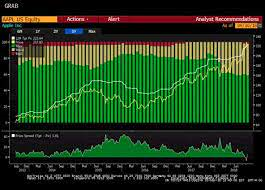
Half the Analysts Following Apple Have a Buy Rating Even Though the Stock is Above Their Target
The shares of AAPL have surged above $500 per share after having risen 70% year to date. Most of the surge has come since the company announced a four-for-one stock split on July 30th. Since the stock split announcement, the shares of AAPL have risen approximately 30%. Sixty-one percent of the analysts following the stock have a positive rating on the shares of AAPL despite the shares trading above price targets. The highest price target is $520 per share, and the average price target is $430 per share. Whether or not analysts following AAPL raise their price targets or lower their ratings remains to be seen. The current disparity, however, raises a bigger picture question: do analyst price targets matter at all? In theory, an analyst’s price target is an indication of where an analyst thinks the stock will trade at a future date (usually twelve months). As such, the difference between an analyst’s price target and the current stock price is a measure of how much an analyst believes the stock is under or overvalued. In reality, price targets do not fully reflect an analyst’s sentiments regarding a stock for reasons discussed below.
Bull Case (price targets are useful)
Price targets are regulated and can not be arbitrary. Following the collapse of Enron in 2002, regulators added additional restrictions regarding the use of price targets. FINRA rules 2241 and 2241 require that price targets have a “reasonable basis” and include a disclosure of risks that may impede achievement of the price target. Most analysts will justify their price targets mathematically, perhaps by applying a price-to-earnings ratio, a sum-of-the-parts calculation, or a discounted cash flow estimate.

Price targets imply direction more than magnitude. As mentioned earlier, price targets represent an analyst’s estimated value of a stock. That value, however, is not static. It may be based on many factors that are constantly changing, including company fundamentals, its competitive environment, overall stock market conditions, interest rates, and many other factors. In theory, an analyst should be changing his or her price target every day if not continuously. This, of course, is impractical. As such, investors should pay more attention to the direction of price targets, especially when they are updated. A study by researchers at the University of Waterloo and Boston College found that analyst target price revisions are more accurate predictors of future stock price performance than the actual price target.
Price targets lag behind changes in fundamental company developments but will adjust. Analysts will typically review their price targets whenever they write a report. They will take into account all changes that have occurred since their last report. However, they will probably not make a change to their price target unless the change is significant. If a drop in interest rates warrants raising a price target by $0.50, they may decide to wait until conditions warrant a larger change. Consequently, price target levels typically lag minor changes in company fundamentals or other data points.
Bear Case
The analyst just raises their targets when they are hit. Although analysts tend to think of price targets as a way to communicate their feelings on a stock, some investors and traders view them as a price limit for buying the stock. Investors and traders get frustrated when analysts simply raise their price targets when stock prices reach their target. The chart below shows the stock price of Apple shares (yellow line graph) and the median twelve-month price target for Apple (white line graph). As you can see, the two lines mirror each other, with the gaps growing during periods when the stock price has stagnated. As indicated earlier, this may be a function of the fact that analysts are not constantly changing their targets, instead of waiting until the fundamental change is large enough to make a major move. Often, such a move occurs when a company releases earnings or other news. Of course, such an announcement often is associated with an increase in the company’s stock price. Analysts try to stay ahead of the stock price, but that is not always possible when there are sudden moves.

Price targets are sticky on the downside. Price targets typically increase over time. If an analyst used a P/E ratio to set a price target, the price target would increase each year, assuming the company is growing earnings. Occasionally, company fundamentals or other factors deteriorate, causing an analyst to lower high price targets. This is certainly true in situations where a company makes a major negative announcement. It is less true when a company’s fundamentals deteriorate slowly. It is not unusual for an analyst’s price target to become outdated under such a scenario.
Conclusion
Price targets are a second tool (in addition to a stock’s rating) for analysts to communicate feelings about a stock’s value. Price targets can become outdated when a stock’s price moves quickly. However, that does not mean it is not important. Investors and traders need to be cognizant of the limitations of using price targets for making investment decisions when making decisions regarding buying and selling stocks. Price target changes may provide more information that the price target level. Often, the magnitude of the change or the reasons behind the change tell a more complete picture.
Suggested Reading:
Investors Should Pay More Attention to ATM Offerings
Investment Journalists Would Make Horrific Fund Managers
Fear of Missing Out on the Next Apple
Enjoy Premium Channelchek Content at No Cost
 Each event in our popular Virtual Road Shows Series has maximum capacity of 100 investors online. To take part, listen to and perhaps get your questions answered, see which virtual investor meeting intrigues you here.
Each event in our popular Virtual Road Shows Series has maximum capacity of 100 investors online. To take part, listen to and perhaps get your questions answered, see which virtual investor meeting intrigues you here.
Sources:
https://www.barrons.com/articles/wall-street-analyst-stock-price-targets-51561597085, Al Root, Barron’s, June 27, 2019
https://realmoney.thestreet.com/articles/08/03/2013/why-price-targets-matter, James Deporre, Real Money, August 3, 2013
https://www.theglobeandmail.com/globe-investor/investor-education/what-every-investor-should-know-about-analysts-price-targets/article627565/, John Heinzl, The Globe and Mail, March 29, 2012
https://financialpost.com/investing/analysts-target-prices-rarely-accurate-global-study-finds#:~:text=%E2%80%9CWe%20find%20that%20analyst%20target,subject%20to%20conflicts%20of%20interest.%E2%80%9D, David Pett, Financial Post, March 07, 2013
https://www.finra.org/rules-guidance/rulebooks/finra-rules/2241, FINRA
https://osboncapital.com/price-targets-are-obsolete-why-are-they-still-a-thing/, John Osbon, Osbon Capital Management, September 12, 2018